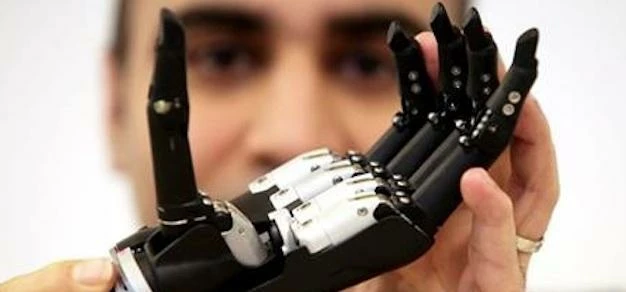
Partner Article
Newcastle University lead £1.4 million bionic hand development
A bionic hand that can sense pressure and temperature and transmit the information back to the brain is the focus of a new £1.4m UK research project.
Led by Newcastle University and involving experts from the universities of Leeds, Essex, Keele, Southampton and Imperial College London, the aim is to develop novel electronic devices that connect to the forearm neural networks to allow two-way communications with the brain.
Reminiscent of Luke Skywalker’s artificial hand, the electrodes in the bionic limb would wrap around the nerve endings in the arm. This would mean for the first time the hand could communicate directly with the brain, sending back real-time information about temperature, pressure and shear force.
Funded by the Engineering and Physical Sciences Research Council (EPSRC), the project is one of three innovative research projects announced today.
Led by Dr Kianoush Nazarpour, a lecturer in Biomedical Engineering at Newcastle University, the team hope to develop a number of enabling technologies to give amputees a real sense of feedback and create a limb that more closely mirrors the real thing.
“The UK leads the way in the design of prosthetic limbs but until now one of the limiting factors has been the technology to allow the hand to communicate with the brain,” explains Dr Nazarpour, who is part of Newcastle University’s Biomedical Engineering team.
“If we can design a system that allows this two-way communication it would help people to naturally reach out and pick up a glass, for example, whilst maintaining eye contact in a conversation, or pick up an apple without bruising it.
“This will advance the field of prosthetics, provide enhanced function to prosthesis users, and also reduce the time involved to learn how to use the device because the movements will come naturally. The technology will also have applications for patients with neurological conditions where reduced sensation is a factor.”
Bringing together some of the UK’s leading researchers in this field of rehabilitation research, the team will build fingertip sensors to give the prosthesis a realistic sense of touch, including pressure, shear and temperature.
In addition, a ‘virtual hand’ will provide information on the sense of the hand’s position and movement, known as ‘proprioception’.
Finally, the system will translate the signals to a form the brain understands and stimulate the nervous system to help the user control the hand.
Building this level of feedback into prosthetic devices will enable much higher levels of function for people who have lost their limbs than is currently available.
Dr Rory O’Connor, Senior Lecturer in Rehabilitation Medicine at the University of Leeds, is the clinical advisor on the project.
“We are seeing many more active young people who are surviving severe injuries that result in them losing one or more limbs and requiring a prosthesis,” explains Dr O’Connor.
“The current designs are like a plug and socket. The socket fits over the end of the limb and picks up signals from the muscles. The prosthesis fits onto this and by learning to flex certain muscles the patient can work the hand.
“The drawback is that for many patients – particularly survivors of trauma – the muscle ends are too damaged to be able to use the limb.
“What patients tell us is they want something that is more intuitive and more closely replicates the natural movement and feel of a real hand and that is what we hope to achieve through this project.”
Looking to promote your product/service to SME businesses in your region? Find out how Bdaily can help →
Enjoy the read? Get Bdaily delivered.
Sign up to receive our daily bulletin, sent to your inbox, for free.








 Apprenticeships: Lower standards risk safety
Apprenticeships: Lower standards risk safety
 Keeping it reel: Creating video in an authenticity era
Keeping it reel: Creating video in an authenticity era
 Budget: Creating a more vibrant market economy
Budget: Creating a more vibrant market economy
 Celebrating excellence and community support
Celebrating excellence and community support
 The value of nurturing homegrown innovation
The value of nurturing homegrown innovation
 A dynamic, fair and innovative economy
A dynamic, fair and innovative economy
 Navigating the property investment market
Navigating the property investment market
 Have stock markets peaked? Tune out the noise
Have stock markets peaked? Tune out the noise
 Will the Employment Rights Bill cost too much?
Will the Employment Rights Bill cost too much?
 A game-changing move for digital-first innovators
A game-changing move for digital-first innovators
 Confidence the missing ingredient for growth
Confidence the missing ingredient for growth
 Global event supercharges North East screen sector
Global event supercharges North East screen sector